AI and Machine learning are revolutionizing the way the world operates. Just a few years ago, it was almost impossible to get a computer to accurately recognize spoken words. Today, voice recognition software like Siri and Alexa are used by millions of people every day. These advanced technologies are being used in everything from self-driving cars to medical diagnosis and even chatbots.
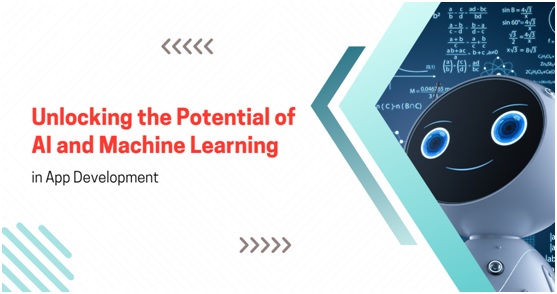
And this is just the beginning, there’s much more to come. In the future, we can expect to see even more impressive advancements in these fields. The most exciting thing about AI services and Machine learning software development is the endless possibilities. They have a lot of potentials to change the way we live and work.
Before moving further, let’s have a look at some interesting facts related to AI and Machine learning
- According to a McKinsey survey in 2021, it is found that the use of AI has increased in companies by 50 % from the prior year.
- Additionally, Artificial Intelligence will have a greater impact on humans as a species than electricity and fire, claimed Google CEO – Sundar Pichai.
- According to AI, the yearly investment from venture capital companies into US enterprises using AI systems have surged by up to six times since 2000.

A Brief Overview of Artificial Intelligence (AI) and Machine learning
AI is a broader term that encompasses various techniques to create intelligent systems. AI services can range from simple rule-based systems to highly sophisticated neural networks that are capable of learning and making decisions in a manner that resembles human intelligence.
On the other hand, machine learning is a sub-component of AI. It is a way for computers to learn from data, without being explicitly programmed. It involves the development of algorithms and statistical models, which can be used to classify data, make predictions and perform other tasks.
Companies are using machine learning to analyze customer data and improve their products and services. In healthcare, AI is being used to assist in medical diagnosis and in discovering new drugs. Even in finance, machine learning is being used to detect fraud and predict stock prices.
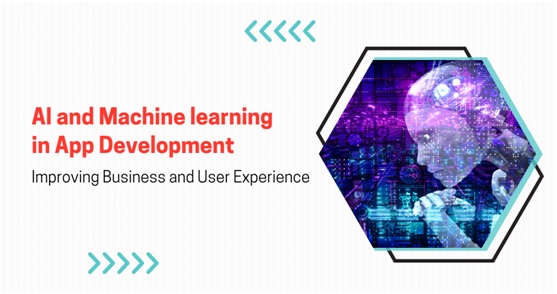
AI and Machine learning in App Development: Improving Business and User Experience
Below are several major reasons why businesses should go for Artificial Intelligence solutions and machine learning app development:
- Personalization and predictive analytics – AI and machine learning can be used to tailor the experience to individual preferences. This results in increased retention and engagement.
- Real-time data analysis: AI services can process large amounts of data in real-time, providing users with immediate feedback and insights.
- Improved efficiency: AI can automate routine tasks, such as data entry and analysis, which can lead to improved efficiency and productivity.
- Better customer service: Artificial Intelligence solutions can help businesses provide 24/7 customer service by automating responses to common customer inquiries and providing personalized assistance.
- Increased functionality: AI and machine learning can be used to add new features and functionality to apps, such as natural language processing, image and speech recognition, and facial recognition.
Overall, these technologies can help businesses improve the user experience, boost engagement, and gain valuable insights into customer needs and preferences.
Despite the advances that have been made in machine learning and AI, there are also some challenges that need to be addressed. One of the main challenges is ensuring that AI systems are fair and unbiased. They can perpetuate and even amplify societal biases if not properly designed. Another challenge is ensuring that these systems are transparent and explainable so that people can understand how they make decisions.
Moreover, safety and security are other concerns with these systems. Machine learning models can be vulnerable to adversarial examples and adversarial attacks that can deceive the models and cause them to make incorrect predictions. This is important to consider while deploying these models to safety-critical domains like autonomous vehicles and healthcare.
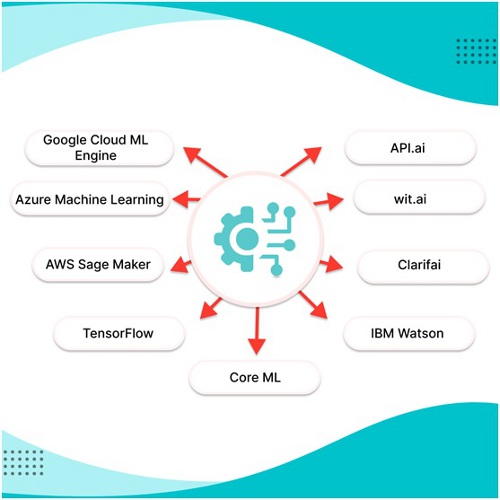
Exploring AI and Machine learning platforms for App Development
Here are some popular platforms used by developers for AI and machine learning app development:
TensorFlow
Developed by Google Brain Team. It is an open-source platform for machine learning that can be used to build and deploy AI models on a variety of devices and platforms. It is used for a wide range of applications including neural network training and interference, natural language processing, image, and video analysis, and more.
AWS Sage Maker
A cloud-based platform that simplifies the process of building, training, and deploying machine learning models. It is a fully managed machine learning service provided by Amazon Web Services (AWS).
Sage Maker provides a number of features including Automatic Model Tuning, pre-build deep learning containers, high-performance computing resources, and development options. All these features allow data scientists and developers to quickly build, train and deploy machine learning models.
Azure Machine Learning
It is a cloud-based integrated development environment (IDE) for building, deploying, and managing machine learning models. In addition, it provides a drag-and-drop interface for creating machine learning experiments, as well as pre-built and reusable machine learning modules.
It also includes tools for data preparation, model evaluation, and deployment. It allows data scientists and developers to quickly and easily build, test, and deploy machine learning models in a collaborative environment.
Google Cloud ML Engine
A cloud-based platform that enables businesses to build and deploy machine learning models on Google Cloud. It offers features like automatic scaling, distributed training, hyper-parameter tuning, deployment options, and model monitoring. All these features make it easy for data scientists and developers to build and deploy machine learning models quickly.
API.ai
It is a platform that allows developers to easily create and manage AI-powered conversational interfaces for a variety of applications. The platform provides a suite of tools and features that can be used to develop chatbots, virtual assistants, voice-controlled devices, and more.
Additionally, it allows developers to train the system to understand and respond to user input in a human-like manner. This engine can be used to create custom intents and entities, which define the types of user input the system should expect and how it should respond.
Wit.ai
It is a platform that allows developers to build apps and services with AI and machine learning capabilities. It provides a set of APIs and tools for understanding and extracting meaning from human language, allowing developers to build conversational interfaces, such as chatbots, voice assistants, and more.
Moreover, the platform allows developers to train their own custom language models. It also provides pre-built models for common tasks such as intent recognition and entity extraction. The platform also includes tools for building and testing conversational interfaces, as well as for analyzing and improving performance.
Clarifai
It is a cloud-based artificial intelligence platform that allows developers to integrate image and video recognition capabilities into apps and services. It includes pre-trained models that can be used for a variety of tasks such as object detection, facial recognition, and image tagging.
Furthermore, the platform supports various programming languages which can be integrated with tools such as AWS, GCP, and Azure. This technology can be used for machine learning software development and Artificial Intelligence solutions including industries such as e-commerce, finance, media, and transportation.
IBM Watson
A cloud-based platform that provides businesses with tools to build, train, and deploy AI models, as well as access to pre-trained models and APIs. It provides a collaborative environment for data scientists and developers to work together on projects. It integrates with a wide range of IBM and third-party tools.
Core ML
It is a framework by Apple for integrating machine learning models into iOS, iPadOS, macOS, watchOS, and tvOS apps. It allows developers to easily add features such as image recognition, natural language processing, and object detection to their apps.
It provides a high-level API that makes it easy to integrate machine learning models into an app, even if the developer doesn’t have a deep understanding of machine learning. The framework supports a wide variety of model types, including neural networks, tree ensembles, and support vector machines.
Consequently, each platform has its own set of features and capabilities. It’s important to evaluate which one best fits the specific needs of your app development project.
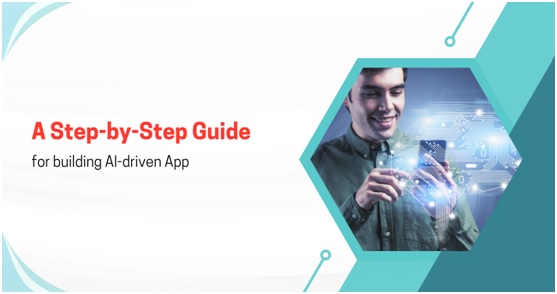
A Step-by-Step Guide for building AI-driven App
Implementing AI in app development typically involves the following steps:
Define the problem
Before you start, identify the problem that you want to solve with AI and determine what type of AI model will be best suited to solving it. This step is critical as it sets the direction for the entire process. For example, if you want to build an app that can recognize objects in an image, you would choose a model that is trained for image recognition.
Collect and prepare data
Following that, collect and prepare the data that will be used to train the AI model. This may involve cleaning and preprocessing the data, and splitting it into training and test sets. Data preprocessing is an important step as it ensures that the data is in the right format and is free of errors. It’s also important to have a good balance of data so that the model can generalize well.
Choose an AI framework
Thereafter, select an AI framework that is well-suited to the problem and the type of model you want to build. Popular frameworks include TensorFlow, PyTorch, Core ML, etc. It’s important to choose a framework that is well-documented. Ensure, it has a large community and provides pre-built models that can be fine-tuned for your specific problem.
Train and the model
Use the collected and prepared data to train the model. This may involve adjusting the model’s hyper-parameters to optimize its performance. During the training process, you can use techniques such as cross-validation and grid search to find the best set of hyper-parameters for your model.
Test the model using the test data set to evaluate its performance and make any necessary adjustments. You can use metrics such as accuracy, precision, recall, and F1 score to evaluate the model’s performance.
Deploy the model
Deploy the model to the environment where it will be used, such as on a mobile device or in the cloud. Depending on the environment, this step may involve converting the model to a format that is compatible with the target platform and optimizing the model for performance and memory usage.
Integrate the model into the app
Integrate the model into the app, making sure that it works well with the rest of the app’s features and functionalities. This step may involve writing code to interface with the model, and designing the user interface.
Monitor and maintain the model
Monitor the model’s performance and make adjustments as per the requirement. Once the model is deployed, it’s important to keep track of its performance and make adjustments as necessary. This may involve retraining the model with new data, or adjusting the model’s hyperparameters.
In short, building an AI app involves a combination of machine learning, data science, and software development. It’s important to have a good understanding of the problem, data, and model, and to choose the right tools and technologies for the job. Additionally, it’s essential to have a good understanding of software development and the target environments.
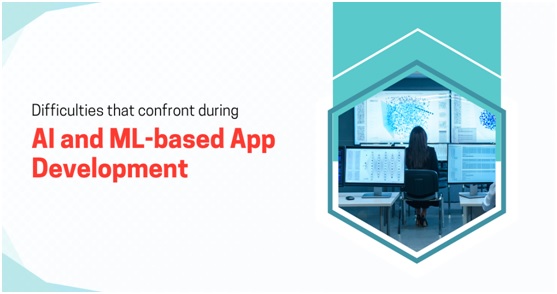
Difficulties that confront during AI and ML-based App Development
There are several challenges that can be encountered when implementing AI and Machine learning in Apps:
Data Quality
High-quality, accurate, and relevant data is essential for training and validating machine learning models. However, collecting, cleaning, and preparing data can be time-consuming and resource-intensive. This includes dealing with missing data, and outliers, and ensuring data is consistent and formatted correctly.
Model Selection
Choosing the right model for a specific task is crucial for achieving good performance. This requires a deep understanding of the problem and the various models available, as well as the ability to test and evaluate different models. This includes comparing the performance of different algorithms and architectures and choosing the one that best suits the problem at hand.
Scalability
Training and deploying machine learning models at scale can be challenging, especially with large and complex datasets. This includes dealing with distributed data processing, parallelization, and managing the computational resources required for training and deploying large models.
Explainability and interpretability
Machine learning models can be difficult to interpret and explain, making it hard to understand how a model is making predictions. This is particularly challenging for models that use complex algorithms or deep neural networks.
Integration with existing systems
Integrating machine learning models into existing systems and processes can be difficult, especially if the systems are not designed to handle the additional computational requirements of machine learning. This includes dealing with the integration of machine learning models with other software systems and ensuring that the models can be easily deployed and scaled as needed.
Security and Privacy
Ensuring the security and privacy of sensitive data and models is critical when implementing AI and machine learning in apps. This includes dealing with issues such as data encryption, secure transmission of data, and protecting against unauthorized access to models and data.
Lack of skilled resources
Building and deploying machine learning models requires specialized skills, including a deep understanding of machine learning algorithms and techniques. This includes dealing with the shortage of skilled resources such as data scientists, machine learning engineers, and developers, which can be a major challenge in developing AI and ML-based applications.
Model Maintenance
Keeping the model updated and relevant to real-world situations can be a challenge. This includes dealing with concept drift and regular retraining, monitoring, and improving the performance of the model.
Ethics and Bias
AI and Machine learning models can be biased due to the data they are trained on. Thus, it is important to consider the ethical implications of the model and to ensure that the model is fair and unbiased.
Hence, to overcome these challenges, developers can use pre-trained models and transfer learning, which allows them to leverage existing models and fine-tune them for their specific use. Additionally, using cloud-based AI platforms can make it easier to scale and deploy models. Ensuring data privacy and security can be achieved by using techniques such as federated learning, differential privacy, and using secure communication channels when transmitting data.

Strategies for overcoming challenges in developing AI-driven apps
The solution to the Data collection challenge is to use pre-existing datasets that have already been labeled for specific tasks. This can save time and resources compared to collecting and labeling data from scratch. Additionally, developers can use annotation tools to streamline the labeling process and make it more efficient.
For model training and optimization challenge. The solution is to use transfer learning, which allows developers to leverage pre-trained models and fine-tune them for their specific use case. This can save time and resources compared to training models from scratch. Further, developers can use cloud-based AI platforms, which provide powerful computing resources for training and optimizing models.
In case of deployment challenges, use cloud-based AI platforms, which provide powerful computing resources and make it easier to scale and deploy models. Additionally, developers can use containerization technologies such as Docker, which allow models to be packaged and deployed in a consistent and reproducible way.
To overcome the Explain-ability and interpretability challenge, use methods such as LIME and SHAP, which can provide insight into how a model is making its predictions. In addition, developers can use visualization tools to create interactive dashboards that allow users to explore and understand the model’s behavior.
To get rid of Privacy and security concerns, you should use federated learning. It allows models to be trained on decentralized data, reducing the risk of data breaches. Additionally, developers can use differential privacy, which adds noise to the data to protect individual privacy while still allowing models to be trained on it. Moreover, developers should use secure communication channels when transmitting data, such as HTTPS and encryption, to protect sensitive user data.
Wrapping Up
In conclusion, Artificial Intelligence (AI) and Machine Learning (ML) are rapidly revolutionizing the way you develop apps. They have the potential to transform a wide range of industries and applications. With these technologies, apps can now become more personalized, efficient, and intelligent. From natural language processing to computer vision, AI and ML can bring a wide range of benefits to app development. For example, natural language processing allows for more accurate and efficient communication between users and apps, while computer vision can enable apps to analyze images and videos and perform tasks including object identification and facial recognition.
Moreover, AI and ML can also help to improve the user experience and make apps more engaging. By analyzing user data, AI can help to personalize content, recommendations, and notifications. Additionally, ML algorithms can be used to improve the performance and speed of apps by learning from user data and predicting future behavior.
However, it is important to remember that these technologies also bring new ethical and privacy concerns. AI and ML algorithms can perpetuate biases if they are not trained on diverse data sets. And they can also raise concerns about data privacy and security. Therefore, developers must consider these issues when building AI-powered apps.
Overall, AI and Machine learning are powerful tools that can greatly enhance the capabilities of apps and bring new possibilities to app development. As these technologies continue to evolve, we can expect to see even more innovative and sophisticated apps in the future. The key is to use Artificial Intelligence solutions and machine learning app development responsibly and with a focus on improving the user experience and addressing ethical concerns. Hence, it’s a technology that’s worth keeping an eye on!
At Orange Mantra, we create customized AI solutions and machine learning development services that match industry standards. Get a quote, if you are looking for AI and Machine learning app development.
